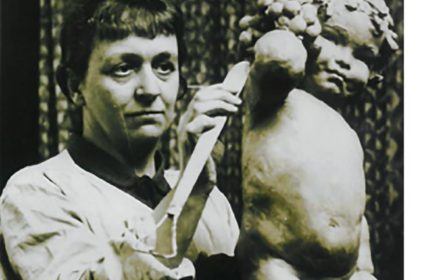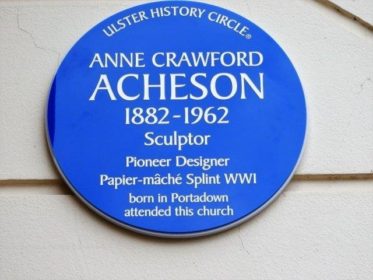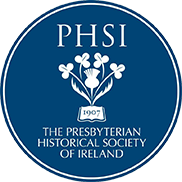Anne Crawford Acheson CBE, FRBS, RUA (1882-1962)
Sculptor and Inventor of plaster of Paris limb splints
 Anne Crawford Acheson was born into a prominent Portadown Presbyterian family on 5 August 1882 at Carrickblacker Avenue and was the third of the seven children of John and Harriet Acheson (née Glasgow), an accomplished poet and a formidably well educated woman. Her father was a pharmacist and a partner in J & J Acheson (Bannview Weaving, a linen firm on the Garvaghy Road), and later a JP. He was also a councillor on Portadown Urban District Council. John and Harriet were married in Belfast on 26 December 1877.
Anne Crawford Acheson was born into a prominent Portadown Presbyterian family on 5 August 1882 at Carrickblacker Avenue and was the third of the seven children of John and Harriet Acheson (née Glasgow), an accomplished poet and a formidably well educated woman. Her father was a pharmacist and a partner in J & J Acheson (Bannview Weaving, a linen firm on the Garvaghy Road), and later a JP. He was also a councillor on Portadown Urban District Council. John and Harriet were married in Belfast on 26 December 1877.
Joseph Acheson, her paternal grandfather had been the minister of Castlecaulfield Presbyterian Church. Her maternal grandfather, the Rev James Glasgow, was one of the first of the Presbyterian Church in Ireland’s missionaries to India. A gifted linguist, he translated the Bible into Gujarati. He later became Professor of Living Oriental Languages at Assembly’s College Belfast and at Magee College, Londonderry.
Like many of her generation and background Anne was reticent on matters of faith but she was a baptised and devout Presbyterian and worshipped with her family at First Portadown Presbyterian Church (Edenderry). When she lived in London she attended regularly at St John’s Presbyterian Church in Kensington and in retirement at Crumlin Presbyterian Church.
Anne was educated at the Alexandra School in Portadown and Victoria College in Belfast, where her mother had been both a pupil and teacher. Like her mother, Anne too was an academic flyer. She studied at the Belfast School of Art from which she won a scholarship to the Royal College of Art in Kensington, London, where she studied sculpture under Edouard Lanteri from 1906 to 1910.
On completing her studies Anne toured northern Italy, visiting Rome, Assisi, Florence and Venice, prior to becoming a teacher in Putney in the autumn of 1910. When Acheson left Putney in 1913, she continued to take private pupils though she did not take up another teaching post. A year later, both Acheson’s parents died and Anne received a bequest of £3,000.
Acheson began exhibiting her sculptures at the Royal Academy in 1913, when ‘The Pixie’ was accepted. From then until 1949 she exhibited 22 times, 30 works in all, with a mixture of statuettes, portrait heads and figurines for the garden. She originally modelled small bronze statuettes and later turned to garden figures in lead as well as modelling china figurines for Royal Worcester.
She also exhibited at the Royal Hibernian Academy Annual Exhibitions in 1910 and 1914, the Annual Exhibitions of the Belfast Arts Society in 1926, 1927 and 1930 and the Ulster Academy of Arts in 1934, 1936, 1948, 1949 and 1950 as well as in other arts venues throughout the UK. She exhibited at the Paris Salon and in Rome, Brussels, Stockholm and Toronto.
She was one of the first women to become an associate member of the Royal Society of British Sculptors, the first woman Fellow in 1938 and a member of its Council in 1944. She received the Feodora Gleichen Memorial Award in 1938.
Among other works, she was responsible for the portrait bust of the Gertrude Bell Memorial (designed by JM Wilson ARIBA), the original of which is in the National Museum in Baghdad. A truly astonishing woman, Gertrude Bell was a writer, traveller, political officer, administrator, spy and archaeologist, who played a significant role, for good or bad, in the creation of Iraq.
Acheson achieved particular success in the 1920s and 1930s as a sculptor of children, which had become fashionable among the well-off who wanted to immortalise their offspring. She also modelled a range of motor mascots for the automobiles of the 1920s and 1930s.
The great majority of her works exhibited were bronze statuettes and garden or fountain figures under such titles as ‘The Imp’, ‘Water Baby’, ‘Watersprite’, ‘Mischief’ and ‘Boy with Puppy’. Acheson regarded playfulness as one of the requirements of garden sculpture. Her sculptural qualities were and are still highly esteemed.
During the Great War Acheson had worked as a volunteer for the Surgical Requisites Association (SRA) at 17 Mulberry Walk in Chelsea. The Association supplied medical dressings and had been created by Queen Mary's Needlework Guild. Acheson and Elinor Hallé, both sculptors, witnessed soldiers returning from the Front with broken limbs held together with only wooden splints and basic bandages, As a sculptor, Anne had a comprehensive appreciation of human anatomy and was fully conversant with how the human body moves. She developed arm cradles with the assistance of Elinor Hallé (whose father had founded the Hallé orchestra). The cradles were made of papier maché (made from old sugar bags) soaked in a paste that could be easily moulded into shape. Up to this point broken limbs had been roughly set using wooden splints. These splints very often did not hold the bones in the correct position. As a result, the fracture healed badly. Using a papier maché arm cradle made a significant difference to the healing process as it kept the bones in the right place.
Anne worked tirelessly to perfect her idea. Originally, the cradle was not made specifically for each patient, but Anne realised that it could be moulded to fit each unique fracture. Patients who were able come to the SRA offices had their papier maché splint applied directly. By 1917 it occurred to Anne that the plaster of Paris that they had been using to create moulds for the papier maché would actually make for an even better splint. For this important work she was awarded a CBE in 1919, as was Elinor Hallé.
During the Second World War Acheson retrained as a precision engineer and draftswoman to undertake voluntary work. She also worked for the Red Cross.
In the 1950s Acheson returned to live with her sisters (Grace Faris MBE – previously headmistress of Victoria College, Belfast, and Hazel Acheson OBE who had retired from the Indian Medical Service). They rented Glebe House, Glenavy, Co Antrim where Anne remained for the rest of her life. She died in Lagan Valley Hospital, Lisburn, on March 13 1962. She never married. According to Virginia Ironside, her great niece, she was ‘madly in love with someone in the [Great] War but he died’.

A Blue Plaque in Anne Crawford Acheson's honour was erected by the Ulster History Circle at First Portadown Presbyterian Church in September 2018 and unveiled by her great nephew, the Rev John Glasgow Faris.
Although possessing an international reputation as a sculptor and deserving recognition for the invention of the plaster splint, until recently, Anne Crawford Acheson was a largely a forgotten figure, not least in her native town. In 2010 David Llewellyn published a biographical study entitled ‘The First Lady of Mulberry Walk’. Craigavon Museum Services mounted in her honour a highly esteemed exhibition entitled ‘Anne Acheson: A Sculptor in War and Peace’ at the Millennium Court Arts Centre, Portadown, in April and May 2019 and they have carried out various other initiatives to ensure that she is now not forgotten.
We gratefully acknowledge the permission of Gordon Lucy to reproduce his article on Anne Crawford Acheson with some amendments and additions by Neil Faris and the Rev John Faris.
